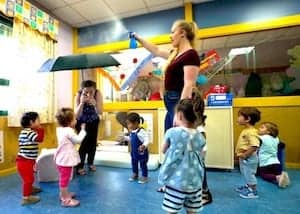Having expertise in the classroom is critical to ensure children have access to the auditory curriculum and other learning experiences.
By Krista Yuskow, AuD, R.Aud
You’ve diagnosed a school-aged child with hearing loss, fit and verified hearing aids, and counseled the child and parents about benefits, challenges, and expectations. Targets were met and the family seemed to understand the information you provided. They came in for their two-week follow-up appointment with no issues. You also fit a remote microphone DM system which you provided at the follow-up appointment. The family seemed to understand the benefit of the DM system and were excited to use it. You feel good about the fitting and plan to see the family again in six months. You have provided the child with great audibility and access to speech sounds. Fantastic! Now, what happens next? What happens after the child leaves your clinic?
Real-world communication experiences are fraught with barriers unaddressed by met targets and parental understanding. For children, the school environment contains the crux of these barriers. For example, access to a teacher’s voice is a primary concern, as teachers are the purveyors of the curriculum. Not to worry, you fit a remote microphone personal DM system!
Thank you to all clinical audiologists who promote and recommend these systems, as without them, many of your patients are effectively absent from school. But is the remote microphone being used correctly? Or is it even being used at all?! Who knows?!
Why Children Need Audiologists with Classroom Access
Some parents seem to understand the benefit and need of the remote microphone and follow through with ensuring that it makes it to school. Others are told by the teacher that they already use a “classroom microphone” so the personal DM RM-HAT is not needed, and as a result, it remains in the box. Parents may or may not send the hearing technologies to school; they may or may not take the time to show the teacher how to use them, and very few parents can impart the technologies’ importance. Use (or non-use) of RM-HAT is only one example of how the hard work of clinical/dispensing audiologists can be undone. Having eyes and expertise in the classroom is absolutely critical in ensuring a child’s access to the auditory curriculum and other auditory learning experiences.
Clinical audiologists are not typically able to see the extensive efforts of their programming, verifying, and mapping at work beyond the clinic walls, nor are they privy to the assortment of barriers that may present themselves within the educational setting. While a clinician’s window to their patients’ daily listening environments is limited to subjective feedback, educational audiologists have the unique opportunity of observing and addressing multi-faceted auditory barriers beyond the clinic walls. That said, accessing an educational audiologist may present its own barrier, since the availability of such services varies widely between states.
Further reading: American Academy of Pediatrics Updates Policy Statement on Hearing Risks for Children
Graduate Programs
While audiology graduate programs provide a wide range of coursework and clinical placements in hospitals, community health centers, and private practices, educational audiology course content and school placements are limited or non-existent. This lack of coursework and placements often results in reduced understanding of the role of the educational audiologist; whereas, the benefits of student exposure to educational audiology are vast and shed light on considerations for auditory accessibility apart from hearing technologies.
Further reading: ASHA Urges Families to Identify Signs of Hearing Loss for Children
Roles and Responsibilities
Educational audiologists can be employed by a single school district, contracted by a district, or even provide service to multiple districts across wide-reaching geographical areas. While the COVID-19 pandemic increased opportunities for virtual meetings and interactions, travel (be it between schools or between towns) remains a reality, and educational audiologists are often found taking meetings, returning emails, and eating lunch in their “carffice” (car/office), amongst their multiple suitcases of cords/ cables, remote microphones, portable equipment, and resources.
As all audiologists do, educational audiologists diagnose, manage, and treat hearing problems. But more specifically, educational audiologists are members of the multidisciplinary educational team with knowledge and skills regarding:
• the impact of hearing loss on language, learning, literacy, and social development
• access to the auditory instruction and collaboration presented in the classroom and the greater school community
• least restrictive auditory environments strategies for teaching and learning
• educational goals as indicated on individual education/program plans
Through specialized assessments, classroom observations, and discussions with students, staff, and parents, educational audiologists ensure students’ access to teachers and staff, peers (both in and out of the classroom), and the 21st-century classroom. While addressing classroom acoustics falls directly in the scope of educational audiologists, additional roles and responsibilities include:
• Monitor, recommend, and/or evaluate the effectiveness of hearing technologies in the education environment—this may mean entering into a discussion with clinical/ dispensing audiologist about hearing technologies
• Facilitate a better understanding of hearing, hearing technologies, and the impact of hearing loss on language, learning, literacy, and social development
• Ensure connectivity to Chromebooks, tablets, classroom interactive whiteboards, and augmentative/alternative communication devices
• Counsel and guide students in their development of self-determination (e.g communication strategies, self-advocacy skills)
• Create communities of same-self peers through group workshops, one-on-one meetings, etc.
• Refer for medical, habilitative (e.g., speech-language intervention, auditory training), or other professional activities/ attention
• Collaborate with parents, community agencies, and relevant professionals
• Help implement school hearing screening programs
• Advocate on behalf of students to ensure auditory access in school
In addition to the student and their learning team, educational audiologists often work very closely with teachers of the deaf and hard of hearing, the child’s clinical audiologist, as well as speech-language pathologists, occupational therapists, physical therapists, teachers of the visually impaired, psychologists, language consultants, cultural brokers, and reading specialists.
Population
Educational audiologists work with children from preschool through Grade 12 with hearing losses of varied etiologies and degrees. Several children have identified disorders, including 22 q deletion syndrome, enlarged vestibular aqueduct (EVA) syndrome, auditory neuropathy spectrum disorder (ANSD), Connexin 26 mutation, Waardenburg syndrome, Treacher Collins syndrome, Usher syndrome, Alstrom syndrome, chronic otitis media with effusion, cholesteatomas, microtia, atresia, auditory processing disorder (varied profiles), and autism spectrum disorder (ASD). In addition, some students have multiple, complex medical conditions requiring a multidisciplinary approach to ensure the most comprehensive care.(1)
Working Together
It is ideal when clinical and educational audiologists work together to support a child who is deaf or hard of hearing. To this end, the Educational Audiology Association recently developed the document, Shared and Suggested Roles of Educational Audiologists and Clinical Audiologists, that serves as a framework for discussion and facilitates collaboration between educational and clinical audiologists, in the hopes of providing comprehensive services for the child. It is intended to provide a template of the roles an audiologist can serve to improve communication and clarity for all professionals serving school-aged children. Roles and responsibilities may vary based on each provider’s areas of expertise and availability.
Summary
About 2 to 3 out of every 1,000 children in the United States are born with a detectable level of hearing loss in one or both ears,(2) and the prevalence of a mild hearing loss in school-age children in the United States is estimated to be between 2.4% and 14.9%, according to a 2020 study.(3) Considering these statistics, it is likely that several students in every school district have some degree of hearing loss. How can we be sure that ALL students with any degree of hearing loss have appropriate access to the educational curriculum?4 While clinical audiologists can provide tools to improve students’ hearing experience in an educational environment, they are not in school and are therefore limited in their ability to make an impact. This is why it is so important that children with any level of hearing loss have access to the services of an educational audiologist to ensure they will be able to reach their potential in school.
About the Author: Krista Yuskow, AuD, R.Aud, has worked in several environments in the U.S., New Zealand, and Canada, and for the past 22 years, has been providing school-based audiology services to various school boards in Alberta, Canada. She lectures, presents, and publishes in areas related to educational audiology both nationally and internationally. She is also currently the president of the Educational Audiology Association.
A version of this article originally appeared in Canadian Audiologist.
Featured image: Educational audiologists work with children from preschool through Grade 12 with hearing losses of varied etiologies and degrees. It is ideal when clinical and educational audiologists work together to support a child who is deaf or hard of hearing. Photo: Dreamstime
References
- Centers for Disease Control and Prevention (CDC). Identifying infants with hearing loss – United States, 1999-2007. MMWR Morb Mortal Wkly Rep. 59(8): 220-223.
- Elbeltagy R. Prevalence of Mild Hearing Loss in Schoolchildren and its Association with their School Performance. Int Arch Otorhinolaryngol. 2020;24(1):e93-e98. doi:10.1055/s-0039-1695024
- Musiek F. 2022. Pathways Interview with Amy Bradbury, Educational Audiologist. Pathways, November 2022. Available at: https://hearinghealthmatters.org/pathways/2022/pathways-interview-with-amy-bradbury-educational-audiologist/
- Spanger C. 2016. Student with Hearing Loss? Why the Educational Audiologist needs to be on YOUR school team! Ohio Board of Speech-Language Pathology and Audiology. Summer Quarter Newsletter, p. 7.
Resources
- Educational Audiology Association. 16 Reasons Why Your School Needs an Educational Audiologist (2010). Available at: https://www.edaud.org/position-stat/7-position-05-10.pdf
- Educational Audiology Association. Minimum Competencies for Educational Audiologists. Available at: http://www.edaud.org/position-stat/1-position.pdf
- Educational Audiology Association. Outcomes of School Based Audiology Services (2017). Available at: http://edaud.org/pdf/outcomes-project.pdf
- Educational Audiology Association (2009). Recommended Professional Practices for Educational Audiology. Available at: www.edaud.org
- Guidelines for audiology service provision in and for schools [Guidelines]. Available at: https://www.asha.org/policy/gl2002-00005/
- School-Based Audiology Services. Available at: http://www.edaud.org/advocacy/6-advocacy-09-09.pdf





